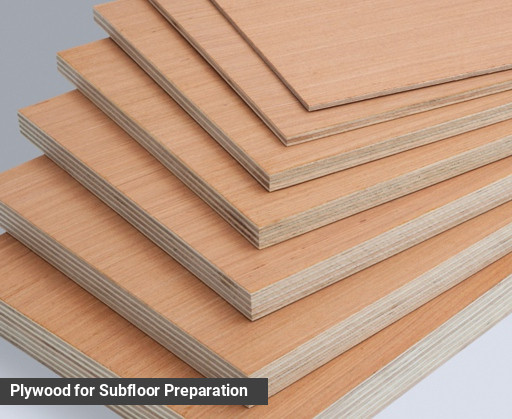What is the importance of the subfloor type and level for wooden floor installation?
What is Subfloor?
Subfloor is the structural layer that new wooden floors are laid onto. There are three main types of subfloors, each with distinct materials, features, and purposes. Here's an overview of each type:

Plied Subfloors
Plywood, an engineered wood product made of cross-laminated wood veneers, is an excellent choice for subflooring under wood flooring. Its cross-grain construction provides superior dimensional stability, strength, and resistance to warping, creating a rigid and flat base essential for a long-lasting and squeak-free wood floor. It holds fasteners well and is available in various thicknesses to suit different structural needs and joist spacing.
Structural ply in thickness of 18 mm or 25 can be laid directly on joists. Plywood in 6, 9, or 12 mm thickness is used to level out timber subfloors and quite common for floorboards.
Chipboard
Chipboard (also known as particle board) is an engineered wood product made from wood particles (chips) bonded together with resin under heat and pressure. As a subfloor material for wood flooring installations, it's primarily chosen for its cost-effectiveness and ease of installation.
For subfloor applications, chipboard typically comes in 18mm to 22mm thicknesses. The specific thickness required often depends on the spacing of the floor joists:
18mm P5 grade chipboard is generally suitable for joist centres up to 400mm.
22mm P5 grade chipboard is recommended for joist centres of 400mm to 600mm, offering greater strength and rigidity.
It's common to use P5 grade (V313) chipboard, which is specially designed to be moisture-resistant and load-bearing, making it suitable for flooring in residential properties, including areas with some humidity like kitchens and bathrooms (though plywood is often preferred in very wet areas).
Chipboard is typically used in new built residential property, major renovations and loft conversations.
Floorboards
Original pine floorboards, common in older homes, served as both the structural floor and often the finished surface. When used as a subfloor base for new wood flooring, they are characterized by their softwood nature, variable condition, and inherent movement.
Condition & Stability: Pine is a softer wood, prone to wear, cupping, and gaps over time. Boards must be sound (no rot or significant damage), securely fixed (screw down all loose boards to eliminate squeaks), and relatively flat. Significant unevenness must be addressed by sanding, shimming, or overlaying with new sheet material.
Due to their inherent movement, potential for unevenness, and gapping, it is highly recommended to install a rigid overlay of plywood (min. 9-12mm) directly over original pine floorboards. This creates a consistently flat, stable, and seamless substrate, crucial for the long-term performance and appearance of most modern wood flooring types.
Concrete
Concrete slabs are a common subfloor base, particularly in ground-floor rooms of modern constructions or conversions. They offer a highly stable, rigid, and durable foundation for wood flooring.
Moisture Control is Paramount: Concrete is porous and can wick moisture from the ground or retain moisture from the curing process. This is the most critical factor.
Moisture Testing: A mandatory step. Use professional moisture meters (e.g., calcium carbide method or hygrometer) to ensure the moisture content is within acceptable limits for the specific wood flooring product.
Damp Proof Membrane (DPM): A robust DPM (liquid applied or sheet plastic) is almost always required over the concrete slab, even if a DPM was installed below the slab during construction, to prevent residual or rising damp.
New concrete slabs require significant time (often weeks or months) to fully cure and dry out before wood flooring can be installed.
Method of flooring installation based on the subfloor?
| Flooring Type | Plywood | Chipboard | Floorboards | Concrete |
|---|---|---|---|---|
| Solid Wood | Glue-down / Nail-down | Glue-down | Nail-down | Glue-down, DPM |
| Engineered Wood | Glue-down / Underlay | Glue-down / Underlay | Underlay | Glue-down / Underlay |
| Laminate Flooring | Underlay | Underlay | Underlay | Underlay |
| Parquet Flooring | Glue-down | Glue-down | Subfloor Prep* | Glue-down |
| Bamboo Flooring | Underlay | Underlay | Subfloor Prep* | Underlay |
| Cork Flooring | Underlay | Underlay | Underlay | Underlay |









